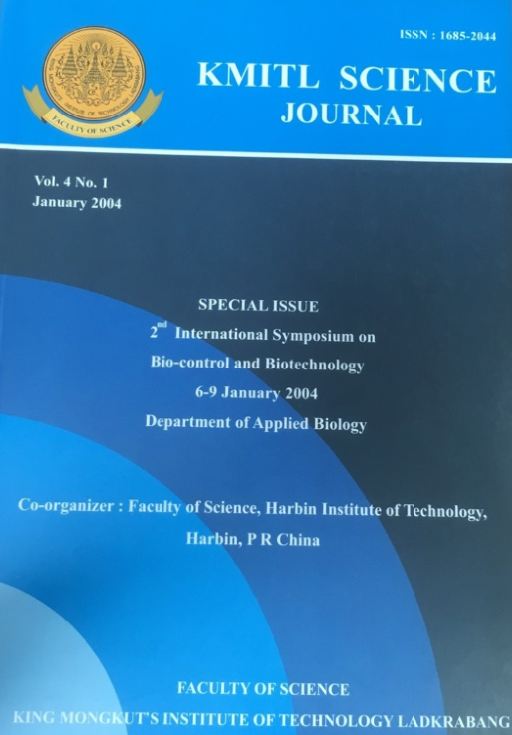Study on Gene Transformation and Expressed Sequence Tags of Chaetomium globosum
Main Article Content
Abstract
In order to improve the bio-control fungus- Chaetomium globosum, and develop a new bio-fungicide, the resistance gene to benzimidazole fungicides was transformed into the fungus, and the expressed sequence tags (ESTs) of the fungus were sequenced. The results showed that the plasmid constructed in this study could improve the transformation rate significantly, (i.e. nearly 9 times higher than before). A cDNA library was constructed from the mycelium of the fungus and 3507 clones were randomly selected for sequencing. 1381 sequences were obtained, 868 of them are new genes. Analysis of the identified clones indicated sequence similarity to the genes encoding proteins such as enzymes, regulatory factors and the product related to plant disease bio-control.
Keywords: Chaetomium globosum, benzimidazole resistance, gene transformation, expressed sequence tags
Corresponding author: E-mail: yangq@hope.hit.edu.cn
Article Details
Copyright Transfer Statement
The copyright of this article is transferred to Current Applied Science and Technology journal with effect if and when the article is accepted for publication. The copyright transfer covers the exclusive right to reproduce and distribute the article, including reprints, translations, photographic reproductions, electronic form (offline, online) or any other reproductions of similar nature.
The author warrants that this contribution is original and that he/she has full power to make this grant. The author signs for and accepts responsibility for releasing this material on behalf of any and all co-authors.
Here is the link for download: Copyright transfer form.pdf
References
[2] Q.Yang, J.Z. Song, L.Q. Liu et al. 2000. A study on biocontrol mechanism of Chaetomium spp. Advanced study on plant pest biological control. (Heilongjang Science and Technology Press, 2000).
[3] A.Dipietro, M. Gut-rella, J.P. Pachlatko, et al., Role of antibiotics produced by Chaetomium globosum in biocontrol of Pythiumultimum, a casual agent of damping-off, Phytopathology, 182 (2), 1992, 131-135.
[4] Q.Yang, Resistance of plant pathogen to fungicides (Harbin: Heilongjang Science and Technology Press, 1995).
[5] S. G. Mark, J.S.L. Raymond, B. Srirama et al., Pathogenicity and growth of Metarhizium anisopliae stably transformed to benomyl resistance, Current Genetics, 17, 1990, 129-132.
[6] M.D. Adams, M. Dubnick, A.R. Kerlavage, R. Moreno, J.M. Kelly, T.R. Utterback, J.W. Nagle, C. Fields and J.C. Venter, Sequence identification of 2375 human brain genes, Nature. 355, 1992, 632-634.
[7] M.D. Adams, J.M. Kelley, J.D. Gocayne, M. Dubnick, M.H. Polymeropoulos, H. Xiao, C.R. Merril, A. Wu, B. Olde, R.F. Moreno, A.R. Kerlavage, W.R. McCombie and J.C. Venter, Complementary DNA sequencing: expressed sequence tags and the human genome project., Science, 252, 1991, 1651-1656.
[8] S.F. Altschul, W. Gish, W. Miller, E.W. Myers and D. Lipman, Basic local alignment search tool, J. Mol. Biol., 215, 1990, 403-410.
[9] B. Cernila, B. Cresnar and K. Breskvar, Induction of hsp70 in the fungus Rhizopus nigricans, Biochem Biophys Res Commun, 265(2), 1999, 494-498.
[10] D. Bell-Pedersen, M.L. Shinohara, J.J. Loros and J.C. Dunlap, Circadian clock-controlled genes isolated from Neurospora crassa are late night- to early morning-specific, Proc. Natl. Acad. Sci. USA., 93, 1996 13096-13101.
[11] R.M. Ewing, A.B. Kahla, O. Poirot, F. Lopez, S. Audic and J.M. Claverie, Large scale statistical analyses of rice ESTs reveal correlated patterns of gene expression, Genome Res., 9, 1999. 950-959.
[12] K. Soytong, Application of a new broad spectrum biological fungicide for environment plant protection. Advanced Study on Plant Pest Biological Control. (Harbin, 2000).
[13] H. Kouchi and S. Hata, Isolation and characterization of novel nodulin cDNAs representing genes expressed at early stages of soybean nodule development, Mol. Gen. Genet., 238(1-2), 1993, 106-19.
[14] W.R. McCombie, M.D. Adams, J.M. Kelley, M.G. Fitzgerald, T.R. Utterback, M. Kahn, M. Dubnick, A.R. Kerlavage, J.C. Venter and C. Fields, Caenorhabditis elegans expressed sequence tags identify gene families and potential disease gene homologues, Nature Genet., 1, 1992, 124-131.
[15] M.T. Mcnally and S.J. Free, Isolation and characterization of a Neurospora glucose-repressible gene, Curr Genet, 6, 1988, 545-551.
[16] S. Mekhedov, O. Martinez de llarduya and J. Ohlrogge, Towards a functional catalog of the plant genome: a survey of gene for lipid biosynthesis, Plant Physiol., 122, 2000, 389-402.
[17] T. Newman, F.J. de Bruijn, P. Green, K. Keegstra, H. Kende, L. Mclntosh, J. Ohlrogge, N. Raikhel, S. Somerville, M. Thomashow, E. Retzel and C. Someville, Genes galore: A summary of methods for accessing results from large-scale partial sequencing of anonymous Arahidopsis cDNA clones, Plant Physiol., 106, 1994, 1241-1255.
[18] J. Ohlmgge and C. Benning, Unraveling plant metabolism by EST analysis, Cum Opin. Plant Biol., 3, 2000, 224-228.
[19] R. Waterston, C. Martin, M. Craxton, A. Coulson, L. Hillier, R. Durbin, P. Greem, R. Showkeen, N. Halloran, M. Metzstein, T. Hawkins, R. Wilson R., M. Berks, Z. Du, K. Thomas, J. Thierry-Mieg and J. Sulston, A survey of expressed genes in Caenorhabditis elegans, Nature Genet., 1, 1992, 114-123.
[20] T. Sasaki, J. Song, Y. Koga-Ban, E. Matsui, F. Fang, H. Higo, H. Nagasaki, M. Lhtri, M. Miya, E. Murayama-lg, T.T. Ayano, A. Takasug, T. Niki, K. Lshimaru, T.T. Lkcda, Y. Yamamolo, Y. Mukai, L. Ohta, N. Miyadera, L. Ltavukkala and L. Mmobe, Towards cataloguing all rice genes: large-sacle sequencing of ran-domly chosen rice cDNSs from a callus cDNA library, Plant J., 6(4), 1994, 615-624.


